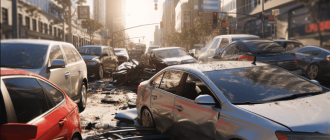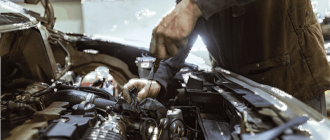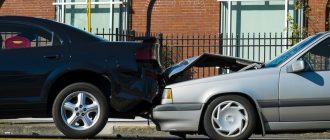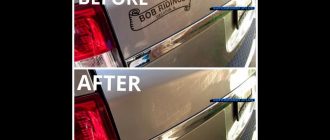
5 Examples of Hidden Damages Found After a Car Accident
Car accidents are often accompanied by visible damages that are immediately apparent. However, there are also hidden damages that may not be visible right away. These hidden damages can pose serious risks and may require costly repairs if left unnoticed. In this article, we will explore five common hidden damages found after a car accident and provide examples of how they can affect your vehicle’s performance and safety.
One of the hidden damages that can occur after a car accident is structural damage. This type of damage affects the integrity of the vehicle’s frame or body. While the external appearance of the car may seem fine, structural damage can lead to issues with stability and safety. For example, a weakened frame can compromise the effectiveness of airbags during a future accident, putting you at a higher risk of injury.
Another hidden damage that may be found after a car accident is electrical damage. This can occur when the wiring or electronic components of the vehicle are compromised. Electrical damage can manifest in various ways, such as malfunctioning lights, issues with the car’s computer system, or problems with the air conditioning. These electrical malfunctions not only affect the convenience and comfort of your driving experience, but they can also impact the overall safety of the vehicle.
Additionally, hidden damages can include damage to the suspension system. The suspension system plays a crucial role in providing stability and a smooth ride. After an accident, components of the suspension system, such as springs, shocks, or struts, can become misaligned or damaged. This can lead to issues with steering, handling, and overall vehicle control.
One less obvious hidden damage that may be unveiled after a car accident is damage to the exhaust system. The force of a collision can cause components of the exhaust system, such as the muffler or catalytic converter, to become damaged or misaligned. This can result in decreased fuel efficiency, increased emissions, and potentially costly repairs if not addressed promptly.
Lastly, hidden damages can also include damage to the alignment and balance of the wheels. Even a minor collision can knock the wheels out of alignment or cause imbalanced tire wear. This can lead to uneven tire wear, decreased fuel efficiency, and compromised handling. It’s essential to have your wheels properly inspected and realigned after a car accident to prevent further damage and ensure optimal performance.
In conclusion, car accidents can result in not only visible damages but also hidden damages that may not be immediately apparent. Structural damage, electrical damage, suspension damage, exhaust system damage, and damage to wheel alignment are just a few examples of the hidden damages that can be unveiled after a car accident. It’s crucial to thoroughly inspect your vehicle after an accident and seek the necessary repairs to ensure your safety and the longevity of your vehicle.
The Importance of Post-Accident Inspection
After a car accident, it is crucial to conduct a thorough post-accident inspection. While the visible damage may be apparent, there are hidden damages that may not be immediately visible but can have serious consequences if left unrepaired. These hidden damages can affect the safety, performance, and value of the car. Here are 5 examples of hidden damages that can be found after an accident:
- Structural Damage: A car’s structure can be compromised after an accident, even if there are no visible signs of damage. This can weaken the overall integrity of the vehicle and make it more prone to future accidents.
- Frame Misalignment: The impact of a collision can cause the car’s frame to become misaligned. This can lead to issues with wheel alignment, suspension, and steering, affecting the car’s handling and stability.
- Hidden Leaks: Following an accident, various fluids such as oil, coolant, or brake fluid can leak unnoticed. These leaks can result in mechanical failures and damage to vital components.
- Electrical Problems: The electrical system of a car can be negatively impacted by an accident. Loose connections, damaged wiring, and blown fuses may not be immediately apparent but can lead to malfunctions in various systems, including the engine, lights, and safety features.
- Internal Component Damage: Important internal components such as the engine, transmission, or suspension can suffer damage in an accident. These damages may not be visible externally but can lead to reduced performance, increased wear and tear, and a shorter lifespan for the car.
By conducting a thorough post-accident inspection, these hidden damages can be identified and addressed promptly. This helps ensure the safety of the driver and passengers, as well as maintains the overall performance and value of the car. It is advised to have the inspection done by a professional who can assess the extent of the damage accurately and recommend the necessary repairs.
Structural Damage: Hidden and Dangerous
When a car accident occurs, it is not uncommon for hidden damages to be found after the initial assessment. One of the most dangerous types of damage is structural damage, which may not be immediately visible but can significantly affect the safety and functionality of the vehicle.
Structural damage refers to any damage to the framework or body of a car. It can result from the force of the impact during an accident or even from a minor collision. Here are five examples of hidden structural damages that can be found after a car accident:
- Twisted frame: The frame of a car is designed to provide structural stability. However, the force of a collision can cause the frame to twist, compromising its integrity and potentially leading to further damage in the future.
- Bent or misaligned chassis: The chassis is the basic framework of a car, providing support for the body and other components. A collision can cause the chassis to bend or become misaligned, affecting the overall balance and stability of the vehicle.
- Cracked or damaged pillars: Pillars are vertical supports that provide structural strength to the roof and body of a car. In a collision, these pillars can crack or become damaged, weakening the overall structure and potentially compromising the safety of the occupants.
- Deformed roof: The roof of a car can sustain significant damage during a collision, leading to deformities or even collapse in severe cases. This can pose a serious risk to the occupants, especially in rollover accidents.
- Undercarriage damage: The undercarriage of a car is particularly vulnerable to damage in accidents, especially from impacts with curbs or low obstacles. Structural damage to the undercarriage can affect the performance and stability of the vehicle.
It is important to note that these hidden structural damages may not be immediately visible after an accident. Therefore, it is crucial to have a thorough inspection of the car conducted by a qualified professional to ensure all damages are identified and repaired. Neglecting to address structural damage can result in further complications and compromise the safety of the vehicle and its occupants.
In conclusion, while some damages may be apparent after a car accident, there are hidden structural damages that can pose serious risks if left unnoticed. It is essential to have a comprehensive inspection of the vehicle to identify and address these damages to ensure the car’s safety and functionality.
Frame Misalignment: A Critical Consequence
After a car accident, there are several hidden damages that may go unnoticed initially. One of the most critical consequences is frame misalignment. This damage occurs when the structural integrity of the car’s frame is compromised, leading to potential safety risks and long-term problems.
Here are five examples of frame misalignment that can be found after an accident:
- Twisted Frame: The car’s frame may become twisted or bent out of shape due to the impact of the accident. This can affect the overall stability and handling of the vehicle.
- Uneven Tire Wear: When the frame is misaligned, the tires may wear unevenly. This can lead to poor traction, decreased fuel efficiency, and the need for premature tire replacement.
- Difficulty Steering: Frame misalignment can cause difficulty in steering the vehicle. The car may pull to one side, requiring constant correction while driving.
- Suspension Issues: Misalignment of the frame can also impact the suspension system. This can result in a bumpy ride, poor handling, and increased stress on other components of the vehicle.
- Structural Damage: If the frame is misaligned, it can indicate underlying structural damage to the car. This can compromise the overall safety of the vehicle and increase the risk of further damage in future accidents.
It is crucial to have a thorough inspection of the car’s frame after an accident to identify any misalignment. Professional auto repair shops have specialized equipment and expertise to accurately diagnose and rectify frame misalignment. Ignoring this hidden damage can lead to further complications and potential safety hazards.
Remember, even if the damages appear minor, it is essential to address them promptly to ensure the safe operation of your vehicle.
Internal Engine Damage: Silent But Costly
In the aftermath of a car accident, it’s important to inspect your vehicle thoroughly for any damage. While some damages may be easily visible, there are hidden damages that can cause serious issues if left unnoticed. One such hidden damage is internal engine damage.
Internal engine damage refers to the harm that occurs within the engine components as a result of an accident. This type of damage is not immediately apparent and can go undetected unless a thorough inspection is carried out by a professional mechanic.
Here are 5 examples of internal engine damage that can be found after a car accident:
- Bent or Broken Connecting Rods: The connecting rods are crucial components in the engine that connect the piston to the crankshaft. A car accident can cause these rods to bend or break, resulting in engine malfunction and potential failure.
- Cracked Cylinder Head: The cylinder head is responsible for sealing the combustion chambers and allowing proper air and fuel mixture. A car accident can cause cracks in the cylinder head, leading to coolant leaks, loss of compression, and poor engine performance.
- Worn Piston Rings: The piston rings create a tight seal between the piston and cylinder wall, allowing for efficient combustion. However, a car accident can cause the piston rings to wear prematurely, leading to decreased engine power and increased oil consumption.
- Damage to Engine Bearings: The engine bearings support the moving parts of the engine and ensure smooth operation. In an accident, these bearings can get damaged or misaligned, leading to increased friction and potential engine failure.
- Internal Oil Leaks: An accident can result in internal oil leaks, causing a loss of lubrication within the engine. This can lead to increased friction between the moving parts, overheating, and ultimately, engine damage.
It’s important to note that internal engine damage can be silent but costly. If left unaddressed, these hidden damages can lead to significant repair costs and even the need for engine replacement. Therefore, it is crucial to have a professional mechanic inspect your vehicle thoroughly after a car accident to ensure any internal engine damage is identified and repaired in a timely manner.
Suspension and Steering System Issues
After a car accident, there can be several hidden damages found on your vehicle. One area that may have issues after a collision is the suspension and steering system.
These components are crucial for the proper functioning and handling of a car, and any damage to them can lead to compromised safety and performance. It is essential to inspect the suspension and steering system thoroughly after an accident to ensure everything is in proper working order.
Here are some examples of hidden damages that can occur:
- Broken or bent control arms: The control arms connect the wheels to the car’s chassis and allow for movement. In an accident, these arms can be damaged or bent, affecting the car’s stability and handling.
- Worn or damaged bushings: The bushings are small rubber or polyurethane components that absorb shocks and vibrations. They can become worn or damaged in an accident, leading to a rough ride or excessive noise.
- Leaking or damaged shocks or struts: Shocks or struts help absorb bumps and keep the car stable. In a collision, they can leak fluid or become damaged, resulting in a bouncy or unstable ride.
- Misaligned wheels: When a car is involved in an accident, the impact can knock the wheels out of alignment. This can cause uneven tire wear, poor handling, and increased fuel consumption.
It is crucial to have a professional mechanic inspect and repair any suspension and steering system issues after an accident. They will be able to diagnose and fix any hidden damages, ensuring your car is safe and performing at its best.
Electrical System Malfunctions: A Hidden Threat
The damages that can be found after a car accident are often obvious and visible, such as dents, scratches, or broken windows. However, there are also hidden damages that may not be immediately apparent but can have serious consequences if left unaddressed.
One of these hidden threats is electrical system malfunctions. When a car is involved in an accident, the impact can cause damage to the wiring and electrical components of the vehicle. This can result in various issues that may affect the car’s performance and safety.
After an accident, it is important to have the electrical system thoroughly inspected by a qualified mechanic. They will be able to identify any damages or malfunctions that may have occurred as a result of the accident.
Here are 5 common electrical system malfunctions that can be found after a car accident:
- Blown Fuses: The impact of an accident can cause fuses to blow, resulting in various electrical components not functioning properly.
- Short Circuits: Cracked or severed wires can create short circuits, causing electrical systems to malfunction or even catch fire.
- Diminished Battery Life: The electrical system of a car is directly connected to the battery. If the system sustains damage in an accident, it can drain the battery more quickly or prevent it from charging properly.
- Malfunctioning Lights: Accidents can damage the wiring or bulbs of the car’s lights, leading to issues such as flickering lights, dimming, or bulbs not working at all.
- Faulty Power Windows: The electrical components that control power windows can be damaged in an accident, causing them to become stuck, slow, or malfunction.
It is crucial to address these electrical system malfunctions promptly to ensure the safety and proper functioning of the vehicle. Ignoring or neglecting these issues may lead to further damages or even accidents in the future.
In conclusion, while the damages that can be found after a car accident are often visible, there are also hidden damages, such as electrical system malfunctions, that may not be immediately apparent. It is important to have a thorough inspection of the electrical system after an accident to identify and address any issues that may affect the car’s performance and safety.
Hidden Fluid Leaks: An Ongoing Problem
After a car accident, there are often hidden damages that may not be immediately apparent. One of these hidden damages is fluid leaks. When a car is involved in an accident, various fluids can leak from damaged parts, causing potential issues down the line.
Here are 5 examples of hidden fluid leaks that are commonly found after an accident:
- Engine Oil: The most common fluid leak after an accident is engine oil. If the oil pan or any other part of the engine is damaged, it can result in oil leaking out. This can lead to engine damage and potentially cause the engine to overheat.
- Transmission Fluid: Another fluid that can leak after an accident is transmission fluid. If the transmission is damaged, it may start to leak fluid. This can cause issues with shifting gears and can ultimately damage the transmission if not addressed.
- Brake Fluid: Brake fluid leaks are particularly dangerous as they can affect the braking system’s functionality. If the master cylinder or any brake lines are damaged in an accident, brake fluid may leak out. This can lead to decreased braking power and compromised safety.
- Coolant: The coolant system is essential for regulating the car’s engine temperature. An accident can cause damage to the radiator or coolant hoses, resulting in coolant leaks. If the coolant level drops too low, the engine can overheat and potentially cause severe damage.
- Power Steering Fluid: Power steering fluid is responsible for making steering easier and smoother. After an accident, the power steering system may sustain damage, leading to fluid leaks. Without sufficient fluid, steering can become difficult and potentially dangerous.
It is crucial to have a professional mechanic thoroughly inspect your car after an accident to identify any hidden fluid leaks. Ignoring these leaks can result in further damage to your car and compromise your safety on the road. Remember, what you can’t see might just be the most significant problem.
Airbag System Damage: A Safety Concern
The airbag system of a car is designed to provide protection to the occupants in case of an accident. However, after a car accident, it is important to inspect the airbag system for any damages as it can affect the safety of the vehicle.

Examples of damages that can be found in the airbag system include:
- Deployment Malfunction: The airbag might not deploy properly or at all in case of an accident if there is any damage to the system.
- Sensor Failure: Damage to the airbag sensors can result in the system not detecting the accident and failing to deploy the airbags.
- Module Damage: The electronic control module (ECM) of the airbag system can be damaged, leading to a malfunction in the overall system.
- Electrical Issues: Wiring and connectors within the airbag system can get damaged, causing electrical faults and preventing the airbags from deploying.
- Structural Damage: If there is significant damage to the vehicle’s structure, it can affect the deployment of the airbags and compromise the safety of the occupants.
It is important to have a professional inspect the airbag system after a car accident to ensure that any hidden damages are identified and repaired promptly. Ignoring or neglecting these damages can pose a serious risk to the safety of the occupants in the event of another accident.
Remember, safety should always be a priority when it comes to a car’s airbag system.
Paint and Cosmetic Damage: Beyond Aesthetics
When thinking about the damages that occur after a car accident, it’s easy to focus on the obvious, such as dents and scratches. However, there are other hidden damages that may not be immediately apparent but can have a significant impact on the overall condition of your vehicle. One such type of damage is paint and cosmetic damage.
Paint and cosmetic damage refers to any harm done to the exterior of your car that affects its appearance. While it may seem like a purely aesthetic concern, it can actually have serious implications for the longevity and value of your vehicle.
Here are five examples of hidden paint and cosmetic damages that you may find after a car accident:
- Paint abrasions: Small scuffs or scratches on the paint surface can not only be unsightly but can also lead to further damage, such as rust and corrosion.
- Chipped paint: When the outer layer of your car’s paint is chipped away, it exposes the metal underneath, leaving it vulnerable to rust and other forms of deterioration.
- Cracked or damaged bumpers: Bumpers are designed to absorb impact during a collision, but they can also suffer hidden damage that affects their appearance and structural integrity.
- Hood damage: The hood of your car is often the first point of contact in a front-end collision, which can result in dents, scratches, and even misalignment.
- Paint overspray: During the repair process, it’s not uncommon for excess paint to get sprayed onto surrounding areas. This overspray can leave unsightly specks and spots on your car’s finish.
It’s important to note that these are just a few examples of the potential paint and cosmetic damages that can be found after a car accident. In many cases, these damages may not be immediately visible, but they can worsen over time and lead to more significant issues.
If you’ve been involved in a car accident, it’s crucial to have your vehicle thoroughly inspected by a professional to identify and address any hidden damages. By taking prompt action, you can ensure that your car remains in the best possible condition and maintain its value in the long run.
Braking System Complications: A Potential Disaster
The braking system of a car is crucial for ensuring the safety of both the driver and other road users. While the external damages resulting from a car accident are visible, it’s important to be aware of the hidden damages that can arise in the braking system. These hidden damages can have serious consequences if left undetected and untreated.
Below are 5 examples of hidden damages that can be found in the braking system after a car accident:
- Brake Fluid Contamination: A car accident can cause the brake fluid to become contaminated with debris, dirt, or even air. This can lead to reduced braking performance or even complete failure of the brakes.
- Brake Line Damage: The impact of a car accident can cause damage to the brake lines, resulting in leaks or blockages. This could lead to brake failure or uneven braking, compromising the car’s ability to stop effectively.
- Master Cylinder Failure: The force of a car accident can damage the master cylinder, which is responsible for transmitting hydraulic pressure to the brakes. A damaged master cylinder can cause the brakes to malfunction or fail completely.
- Caliper Misalignment: The calipers, which hold the brake pads, can become misaligned in a car accident. This can result in uneven braking, increased wear on the brake pads, and reduced stopping power.
- ABS Sensor Damage: The ABS (Anti-lock Braking System) sensors can become damaged in a car accident. This can cause the ABS system to malfunction, affecting the car’s ability to brake safely on slippery surfaces.
It is important to note that these hidden damages may not be immediately obvious after a car accident. To ensure the safety of all occupants and the proper functioning of the vehicle, it is crucial to have a professional mechanic inspect the braking system for any potential complications.
Ignoring or neglecting these hidden damages can lead to disastrous consequences, including loss of control over the car, increased stopping distances, or complete brake failure. Regular maintenance and prompt repairs are essential for keeping the braking system in optimal condition, ensuring the safety of everyone on the road.
Transmission Damage: A Costly Surprise
When it comes to car accidents, there are many damages that can be hidden and may not be immediately apparent. One such example is transmission damage, which can be a costly surprise for car owners.
After an accident, it is typical for car owners to focus on visible damages such as dents, scratches, and broken windows. However, hidden damages can often be found in the transmission system of a car.
The transmission is responsible for transferring power from the engine to the wheels, allowing the car to move. If the transmission is damaged, it can lead to serious issues with the car’s performance, safety, and overall functionality.
Here are 5 examples of hidden transmission damages that may be found after a car accident:
- Fluid Leaks: A car accident can cause cracks or holes in the transmission, leading to fluid leaks. Without proper transmission fluid, the transmission can overheat and fail.
- Shift Linkage Damage: The shift linkage connects the gearshift to the transmission. If it is damaged in an accident, shifting gears may become difficult or impossible.
- Solenoid Malfunction: Solenoids control the flow of transmission fluid. Damage can result in improper fluid flow, causing the transmission to slip or fail.
- Clutch Problems: In manual transmission cars, the clutch connects the engine to the transmission. Accidental impact can damage the clutch, leading to difficulties in engaging or disengaging gears.
- Gasket Leaks: Gaskets seal the different components of the transmission. After an accident, gasket leaks can occur, resulting in fluid loss and transmission damage.
It is important for car owners to be aware of these hidden transmission damages that can occur after an accident. These damages may not be immediately noticeable, but they can have a significant impact on the functioning and longevity of the car.
If you have been involved in a car accident, it is recommended to have your transmission thoroughly inspected by a professional mechanic. Identifying and repairing transmission damage as soon as possible can help prevent further issues and costly repairs down the line.
Exhaust System Damage: Environmental Impact
When a car is involved in an accident, there are various damages that can be found, some of which may not be immediately visible. One hidden damage that can have long-term environmental consequences is the exhaust system damage.
The exhaust system of a car plays a crucial role in reducing harmful emissions and maintaining the overall performance of the vehicle. However, after an accident, the exhaust system can suffer significant damage that may go unnoticed at first.
Examples of exhaust system damage:
- Cracked or dented exhaust pipes
- Loose or damaged exhaust hangers
- Malfunctioning catalytic converter
- Leaking joints or connections
- Damage to the muffler or resonator
These damages can have a direct impact on the environment. When the exhaust system is compromised, it can lead to an increase in harmful emissions, such as carbon monoxide, nitrogen oxides, and particulate matter.
Carbon monoxide is a poisonous gas that can cause various health problems when inhaled, including dizziness, headaches, and even death in extreme cases. Nitrogen oxides contribute to air pollution, leading to smog and acid rain. Particulate matter consists of tiny particles that can penetrate deep into the respiratory system, causing lung damage and cardiovascular issues.
Additionally, a damaged exhaust system can affect fuel efficiency and engine performance. This means that the car may consume more fuel and produce more emissions, further contributing to environmental pollution.
It is essential to have a thorough inspection of the exhaust system after a car accident to identify any hidden damages. Regular maintenance and timely repairs can help prevent and mitigate the environmental impact of exhaust system damage.
Hidden Damages and Insurance Coverage
After a car accident, it is important to evaluate the damages thoroughly. While some damages may be obvious, there are also hidden damages that may only be discovered later on. It is crucial to understand that hidden damages can have a significant impact on the safety and value of your vehicle. Additionally, these damages may not be covered by your insurance policy, resulting in unexpected out-of-pocket expenses.
Here are some examples of hidden damages that are commonly found after a car accident:
- Internal Damage: Despite a car’s exterior appearing undamaged, the impact of a collision can cause internal structural damage, compromising the vehicle’s safety.
- Electrical System Damage: Crashes can disrupt the vehicle’s electrical system, leading to issues with the car’s lights, sensors, or even the engine’s performance.
- Alignment Issues: A seemingly minor collision can knock a car’s wheels out of alignment, resulting in uneven tire wear and handling problems.
- Frame Damage: Sometimes, accidents can cause damage to a car’s frame, which may not be immediately apparent. Frame damage can affect the structural integrity of the vehicle and lead to costly repairs.
- Fluid Leaks: Sudden impacts can cause leaks in various fluid systems of a car, such as the radiator or brake lines, posing potential safety risks.
When dealing with hidden damages, it is essential to review your insurance coverage to understand what is included in your policy. Insurance companies may have specific guidelines and limitations when it comes to covering hidden damages. Some policies may only cover damages that are directly related to the accident and visible at the time of the claim.
It is advisable to document and report any damages promptly after an accident, including both visible and hidden damages. Taking pictures, seeking professional inspections, and keeping detailed records can help support your claim and ensure that any hidden damages are properly documented.
FAQ:
What are some common hidden damages that can occur after a car accident?
Some common hidden damages that can occur after a car accident are misaligned frames, electrical system issues, hidden structural damages, damaged airbags, and internal engine damage.
How can a misaligned frame be a hidden damage after a car accident?
A misaligned frame can be a hidden damage after a car accident because it may not be immediately visible, but it can affect the overall alignment and stability of the vehicle. This can lead to issues with steering, handling, and overall structural integrity.
What kind of electrical system issues can occur after a car accident?
After a car accident, electrical system issues can include malfunctioning lights, problems with the battery or alternator, faulty sensors, or issues with the car’s computer system. These issues may not be immediately apparent but can cause problems with the vehicle’s performance and functionality.
Why is it important to check for hidden structural damages after a car accident?
It is important to check for hidden structural damages after a car accident because these damages can compromise the safety and stability of the vehicle. If the structural integrity is compromised, it can increase the risk of further damage or injury in the event of another accident. Repairing these damages is crucial to ensure the continued safety of the vehicle and its occupants.
Can a car’s airbags be damaged in a car accident without being visibly affected?
Yes, a car’s airbags can be damaged in a car accident without being visibly affected. The impact of an accident can cause damage to the sensors or wiring that activate the airbags, even if the airbags themselves appear intact. It is important to have the airbags inspected and tested after an accident to ensure they are functioning properly.





